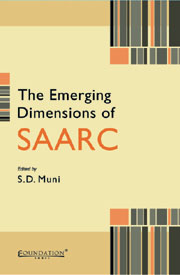Book contents
- Frontmatter
- Contents
- Preface
- List of Figures
- List of Tables
- 1 SAARC Prospects: The Changing Dimensions
- 2 SAARC and South Asian Economic Integration
- 3 Coping with the Emerging Challenges: Poverty and Food Security
- 4 SAARC Energy Cooperation: Energy Security and Environmental Challenges
- 5 Sub-Regional Cooperation under SAARC: An Economic Analysis
- 6 SAARC: Social Charter and Human Security
- 7 SAARC and the South Asian Security Architect
- 8 Fighting Terrorism through SAARC?
- 9 SAARC and the Evolving Asian Regionalism
- 10 Role of SAARC Observers: Members' Perspectives
- 11 Role of SAARC Observers: Observers' Perspectives
- 12 Concluding Remarks
- About the Contributors
- Index
9 - SAARC and the Evolving Asian Regionalism
Published online by Cambridge University Press: 26 October 2011
- Frontmatter
- Contents
- Preface
- List of Figures
- List of Tables
- 1 SAARC Prospects: The Changing Dimensions
- 2 SAARC and South Asian Economic Integration
- 3 Coping with the Emerging Challenges: Poverty and Food Security
- 4 SAARC Energy Cooperation: Energy Security and Environmental Challenges
- 5 Sub-Regional Cooperation under SAARC: An Economic Analysis
- 6 SAARC: Social Charter and Human Security
- 7 SAARC and the South Asian Security Architect
- 8 Fighting Terrorism through SAARC?
- 9 SAARC and the Evolving Asian Regionalism
- 10 Role of SAARC Observers: Members' Perspectives
- 11 Role of SAARC Observers: Observers' Perspectives
- 12 Concluding Remarks
- About the Contributors
- Index
Summary
The Asia-Pacific region lacks a continent-wide regional association and an overarching regional framework is yet to evolve in the region. Currently there are several dialogue forums and conclaves which, among other things, discuss the desirability of an integrated region. This is usually expressed in terms of an emerging Asian community. The phrase ‘evolving Asian regionalism’ therefore should be defined in line with the community-building effort that is underway in the region. The countries from East Asia, Southeast Asia and some from South Asia meet regularly and propose measures that will foster closer regional integration and lead towards an Asian regional community. External powers with a strong interest in regional affairs are also part of such conclaves. Some of these forums are anchored and driven by the Association of Southeast Asian Nations (ASEAN). Prominent among them are the ASEAN Regional Forum (ARF), ASEAN+3 (APT), Asia-Europe Meeting (ASEM), Shangri-La Dialogue, and East Asia Summit (EAS). They hold wide ranging discussions on strategic, economic, environmental and non-traditional cross border security issues such as human trafficking, terrorism and pandemics. The participating states are aware that such cross border threats can only be tackled through collective action which is propelling Asian countries to coordinate their activities more closely. Economic interdependence is a fairly evident phenomenon triggering the need for greater coordination of policies. It is believed that the 1997/1998 regional economic meltdown was a turning point that ‘underscored Asia's integration and shared interests and exposed the weaknesses in the global policy architecture.
- Type
- Chapter
- Information
- The Emerging Dimensions of SAARC , pp. 201 - 228Publisher: Foundation BooksPrint publication year: 2010
- 1
- Cited by



